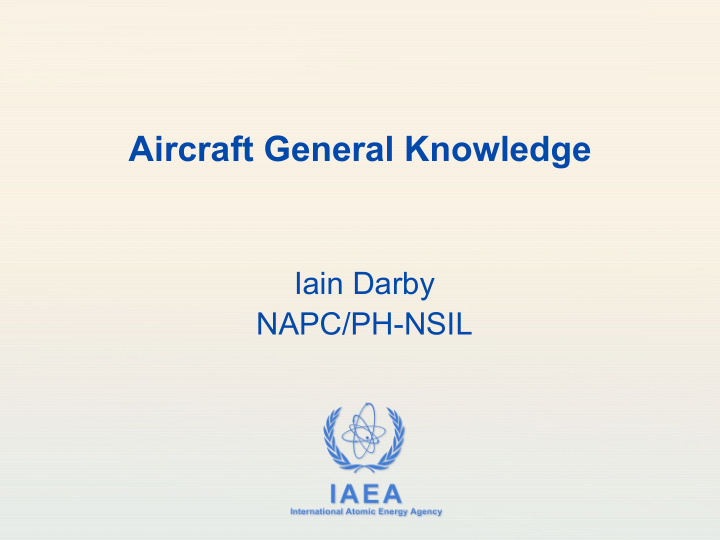



Aircraft General Knowledge Iain Darby NAPC/PH-NSIL IAEA International Atomic Energy Agency
Remotely Piloted Aircraft System RPAS • Remote Pilot must be able to intervene at any moment for the sake of safey • RPA - the remotely piloted aircraft • RPS - the remote pilot station, where the pilot is • Control link - provide critical information • Communication link - data / payload control IAEA #smr2696 #WSNUAV 2 Iain Darby i.darby@iaea.org
Hexacopter IAEA #smr2696 #WSNUAV 3 Iain Darby i.darby@iaea.org
Multicopter System parts • Energy - LiPo batteries • Motors - brushless electric • Propellors • Transmitters • Receivers • Electronic Speed Controllers - control motor speed • Flight Control Unit - accelerometers and gyros • Orientation lights • GPS and other antennae IAEA #smr2696 #WSNUAV 4 Iain Darby i.darby@iaea.org
Airworthiness • At present time there is no ICAO Airworthiness requirement standard. • Patchwork of others IAEA #smr2696 #WSNUAV 5 Iain Darby i.darby@iaea.org
Airframe • The aircraft should always be landed carefully to avoid any damage • When the structure of the airframe is damaged this can easily lead to a misaligned frame that is not visibly noticeable • Damage can also lease to an imbalance and the shocks of heavy landing can damage electronics • One heavy landing doesn’t mean damage occurs but fatigue also occurs in some materials and is cumulative IAEA #smr2696 #WSNUAV 6 Iain Darby i.darby@iaea.org
Operating Modes • Manual / Direct control • continuous intervention of the pilot to maintain flight • Stabilised / Flight Assist Mode • automatic stabilisation to help pilot • aircraft hard to handle otherwise • navigation still controlled by pilot • Pre-programmed / Waypoint Flight • requries GPS and/or inertial navigation sensor • Independent / Autonomous • Possible but usually not allowed IAEA #smr2696 #WSNUAV 7 Iain Darby i.darby@iaea.org
Command Override & Failsafe • An override capability when operating in Waypoint Flight is required • Needed to effect control of the aircraft should there be a malfunction • A mechanism that will cause the aircraft to land in the event of disruption or failure of a system is usually referred to as a failsafe mechanism IAEA #smr2696 #WSNUAV 8 Iain Darby i.darby@iaea.org
Instruments • Instruments provide the pilot with needed information about the behaviour and status of the aircraft • X6 case this includes • battery voltage • flight time • altitude • distance from takeoff location • GPS satellites in view IAEA #smr2696 #WSNUAV 9 Iain Darby i.darby@iaea.org
GNSS - GPS • RPAS community relies on GPS • However, manned flight is not allowed to rely solely on GPS! • Poor reliability and ease of disruption • GPS - 24 satellites, normally 4 in view from anywhere • Since 2011, actually 27 satellites in baseline • About 8 satellites will give accuracy of few metres • GLONASS, Galileo, BeiDou may provide future enhancements IAEA #smr2696 #WSNUAV 10 Iain Darby i.darby@iaea.org
GPS Altitude • GPS zero height defined by WGS84 World Geodetic System 1984 (2004 revision) • Take care: in Europe WGS84 ellipsoid is 30m above sea level (Mean Sea Level, recall AMSL) • GPS precision is also usually quoted for horizontal accuracy • Vertical accuracy is usually much worse. IAEA #smr2696 #WSNUAV 11 Iain Darby i.darby@iaea.org
Batteries - Lithium Ion / Lithium Polymer • High Power density • Capacity - the specific energy in ampere-hours (Ah) • 1000mAh = 1Ah = 1 Ampere x 1 hour • C-rate: measure of the batteries current handling • It is the constant charge and discharge rate the battery can sustain for 1h hour. IAEA #smr2696 #WSNUAV 12 Iain Darby i.darby@iaea.org
LiPo Batteries • During extreme use abnormal crystal growth can occur forming particles which cause a short circuit. • When this occurs the cell temperature rises quickly and approaches the melting point of Lithium • Causes thermal runaway, aka venting with flame • Explosion - take care, 3cells will mean 3 explosions IAEA #smr2696 #WSNUAV 13 Iain Darby i.darby@iaea.org
LiPo Batteries • LiPo discharges to 3.0V/cell • Lowest low-voltage is 2.5V/cell • During prolonged storage self-discharge causes the voltage to drop further • This will cause protection circuit to kick in and “put the battery to sleep” • Cannot be recharged IAEA #smr2696 #WSNUAV 14 Iain Darby i.darby@iaea.org
LiPo Charging • This is the most dangerous part of using LiPo batteries • Do not leave unattended • Advisable to use a safe charging bag • Ensure to use an appropriate charger • Check charging rate is suitable for battery • Recommend is 1C i.e. 5Ah charge at 5A • Use balance mode IAEA #smr2696 #WSNUAV 15 Iain Darby i.darby@iaea.org
LiPo Usage • If battery is in an accident then remove it and put it aside for at least 30mins • If it doesn’t get hot or become misshaped then check it and continue • Do not use a pack that has become misshaped IAEA #smr2696 #WSNUAV 16 Iain Darby i.darby@iaea.org
LiPo Usage IAEA #smr2696 #WSNUAV 17 Iain Darby i.darby@iaea.org
LiPo Storage • Ideally stored in Safe Bag (or other secure container) • between -20degC - +30degC in a dry place • Store at just above 60% capacity • Self discharge between 8-20% capacity IAEA #smr2696 #WSNUAV 18 Iain Darby i.darby@iaea.org
END of AIRCRAFT GENERAL KNOWLEDGE IAEA International Atomic Energy Agency
Recommend
More recommend